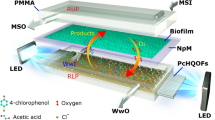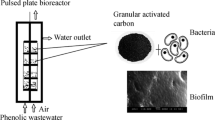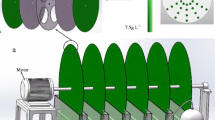Abstract
Activated sludge acclimated to biodegrade phenol was allowed to attach on and in light porous ceramic carriers and to function as a biofilm in a photolytic circulating-bed bioreactor (PCBBR). Phenol degradation in the PCBBR was investigated following three protocols: photolysis with ultraviolet light alone (P), biodegradation alone (B), and the two mechanisms operating simultaneously (P/B). Phenol was degraded at approximately equal rates by B and P/B, each of which was much faster than the rate by P. Furthermore, phenol was mineralized to a significantly greater extent with P/B than with either P or B. SEM showed that the biofilm survived well inside macropores that presumably shaded the microorganisms from UV irradiation, even though the UV light greatly reduced biofilm on outer surface of the carriers in the P/B experiments. Rapid biodegradation of phenol, enhanced mineralization, and survival of bacteria inside macropores demonstrated that being in a biofilm inside the porous carriers protected the bacteria from UV-light toxicity, allowing intimate coupling of photolysis and biodegradation.





Similar content being viewed by others
References
Alinsafi A, Evenou F, Abdulkarim EM, Pons MN, Zahraa O, Benhammou A, Yaacoubi A, Nejmeddine A (2007) Treatment of textile industry wastewater by supported photocatalysis. Dyes Pigm 74(2):439–445
Balcioglu IA, Arslan I (1998) Application of photocatalytic oxidation treatment to pretreated and raw effluents from the kraft bleaching process and textile industry. Environ Pollut 103(2–3):261–268
Enriquez R, Beaugiraud B, Pichat P (2004) Mechanistic implications of the effect of TiO2 accessibility in TiO2–SiO2 coatings upon chlorinated organics photocatalytic removal in water. Water Sci Technol 49(4):147–152
Hu C, Wang Y (1999) Decolorization and biodegradability of photocatalytic treated azo dyes and wool textile wastewater. Chemosphere 39(12):2107–2115
Laspidou CS, Rittmann BE (2002) Non-steady state modeling of extracellular polymeric substances, soluble microbial products, and active and inert biomass. Water Res 36:1983–1992
Li XZ, Zhao YG (1999) Advanced treatment of dyeing wastewater for reuse. Water Sci Technol 39(10–11):249–255
Li T, Tan X, Ren J (2005) Integrated technology of photocatalysis & biology for treatment of organophosphorus pesticides wastewater. J Hebei Univ Sci Technol 26(1):75–78
Manilal VB, Haridas A, Alexander R, Surender GD (1992) Photocatalytic treatment of toxic organics in wastewater: toxicity of photodegradation products. Water Res 26(8):1035–1038
Marsolek MD, Torres CI, Hausner M, Rittmann BE (2008) Photobiocatalysis: intimate coupling of photocatalysis and biodegradation in a photocatalytic circulating-bed biofilm reactor. Biotechnol Bioeng 101(1):83–92
Miao X, Chu S, Xu X, Hu K (1995) Determination of products of phenol with phosphorus-oxygen induced oxidation by the method of chemical derivatization in gas chromatography. Environ Chem 14(5):436–441
Mohanty S, Rao NN, Khare P, Kaul SN (2005) A coupled photocatalytic-biological process for degradation of 1-amino-8-naphthol-3, 6-disulfonic acid (H-acid). Water Res 39(20):5064–5070
Reddy MP, Srinivas B, Kumari VD, Subrahmanyam M, Sharma PN (2004) An integrated approach of solar photocatalytic and biological treatment of N-containing organic compounds in wastewater. Toxicol Environ Chem 86(1–4):125–138
Sakthivel S, Neppolian B, Palanichamy M, Arabindoo B, Murugesan V (2001) Photocatalytic degradation of leather dye over ZnO catalyst supported on alumina and glass surfaces. Water Sci Technol 44(5):211–218
Scott JP, Ollis DF (1995) Integration of chemical and biological oxidation processes for water treatment; review and recommendations. Environ Prog 14(2):88–103
Suryaman D, Hasegawa K, Kagaya S (2006) Combined biological and photocatalytic treatment for the mineralization of phenol in water. Chemosphere 65(11):2502–2506
Wang CX, Yediler A, Lienert D, Wang ZJ, Kettrup A (2003) Ozonation of an azo dye Cl Remazol Black 5 and toxicological assessment of its oxidation products. Chemosphere 52(7):1225–1232
Wei F (2002) Monitoring and analytic methods of water and wastewater, 4th edn. Environmental Science Press of China, Beijing
Zhang H, Bruns MA, Logan BE (2002) Perchlorate reduction by a novel chemolithoautotrophic, hydrogen-oxidizing bacterium. Environ Microbiol 4(10):570–576
Zhou M, Wu Z, Wang D (2003) Characteristic of phenol degradation under various electrocatalysis processes. Chem J Chin Univ 24(9):1637–1641
Acknowledgements
Authors acknowledge the financial support by the National Natural Science Foundation of China (50978164 and 50678102), Special Foundation of Chinese Colleges and Universities Doctoral Discipline (20070270003), Shanghai Leading Academic Discipline Project (S30406), Leading Academic Discipline Project of Shanghai Normal University (DZL711), and the United States National Science Foundation (0651794).
Authors also thank Mr. Qi Tang from Ocean Ceramic Co., Ltd. in Guangdong Province, China, who kindly supplies ceramic raw materials to authors and teaches authors to manufacture light ceramic carrier.
Author information
Authors and Affiliations
Corresponding author
Rights and permissions
About this article
Cite this article
Zhang, Y., Liu, H., Shi, W. et al. Photobiodegradation of phenol with ultraviolet irradiation of new ceramic biofilm carriers. Biodegradation 21, 881–887 (2010). https://doi.org/10.1007/s10532-010-9348-x
Received:
Accepted:
Published:
Issue Date:
DOI: https://doi.org/10.1007/s10532-010-9348-x




